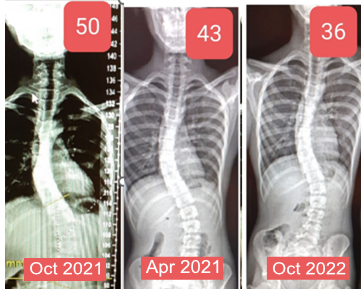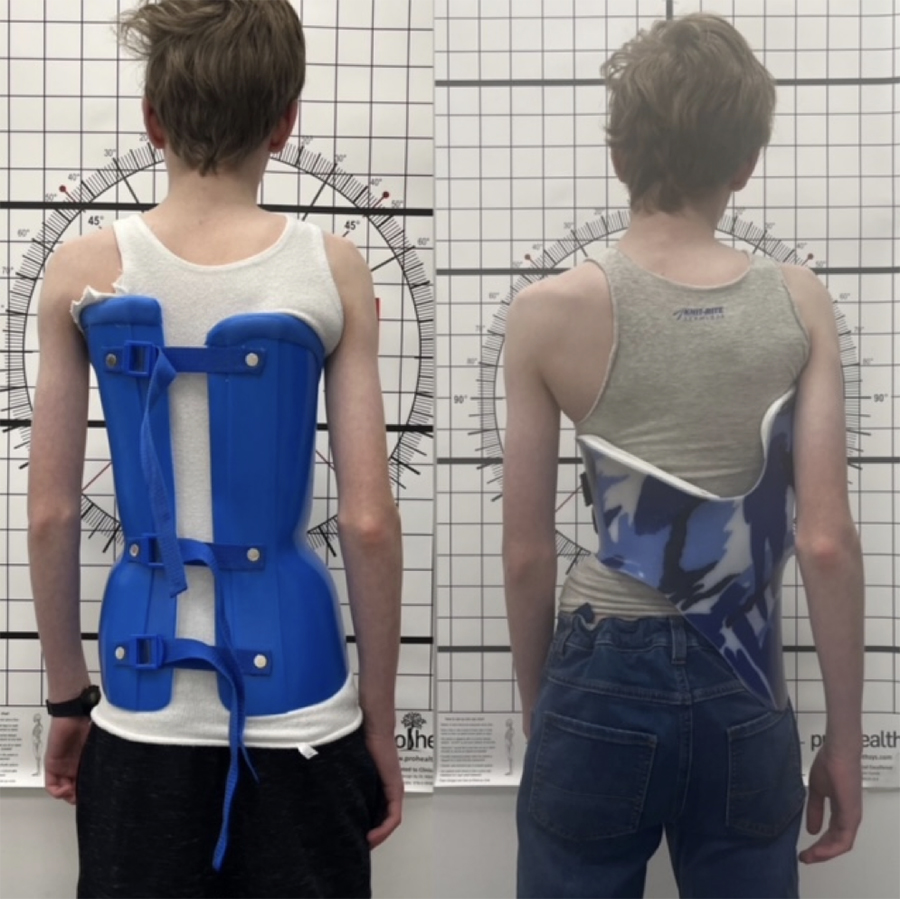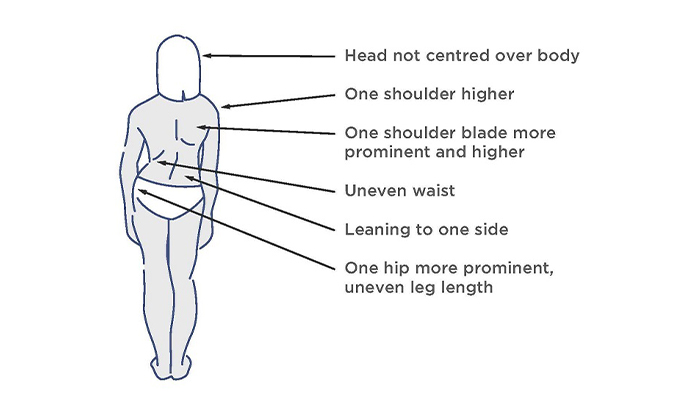
05 December 2022
Our son’s registrar at RNOH said they were the best results he had ever seen from bracing treatment for scoliosis
Beck was diagnosed with idiopathic scoliosis by chance last year. He was chatting with his mum (Donna) at home and looking a bit glum, when asked what the problem was, he explained that he was not looking forward to his Science and Arts lessons because he had to sit on a stool and that made his back really hurt. As Beck was due to see his GP the next day for the routine removal of a wart, Donna thought she would ask the GP to look at his back. Beck was immediately referred for an orthopaedic appointment at St. Peter’s Hospital, Ashford where his X-ray revealed he had a Cobb angle of 45 degrees. Donna was shocked when she saw the image: “I knew his spine should not look like that”. The consultant told Donna that Beck’s condition was so severe he needed to urgently refer him to the Royal National Orthopaedic Hospital (RNOH). A further X-ray was taken and the Cobb angle was now 50 degrees. It is accepted protocol to recommend surgery at this level of severity and certainly, that was the immediate view of the spinal consultant Beck saw.
Donna as she admits was rather emotional at this point: “Nobody is going to put my son under anaesthetic”. She felt that as Beck was in no pain whatsoever and had no mobility issues and indeed no very noticeable physical symptoms, she was very anti-taking the surgical route. As a part compromise, it was agreed that Beck be fitted with a Boston brace which is the standard brace used by the NHS to slow the progression of a scoliosis curve.
There were some practical problems with the brace as it is unfastened/fastened at the back and cannot be done by anybody unaided. This had real mental implications for Beck as he had to ask teachers at school to help him take it off for games and then put it back on, he also could not sit on the loo wearing it. Donna hit the internet: “I thought there must be something better than this”. And this is how Donna found LOC. “LOC was recommended positively on several Facebook groups as having a brace that reduced scoliosis curves.”
Beck was seen by Anna Courtney, LOC’s lead scoliosis clinician, on 22nd February. Donna was impressed: “First of all Anna actually talked to Beck directly about his condition and how he felt. Then Anna noticed that Beck has one leg shorter than the other and needed an insole to correct this, that had not been spotted before. Anna also used an iPad to scan his back, demonstrating that LOC was comfortable using the latest technology– no casting required.”
Beck has been wearing LOC’s Scoliosis brace for nine months now. Donna is so relieved and pleased for her son: “He can go to the park with his mates, nobody can tell he is wearing a brace. We are thrilled with the treatment, it’s priceless.”
Beck was reviewed recently by the consultant’s registrar and Donna immediately e-mailed Anna with good news: “Just back from RNOH. The best appointment ever. We saw our consultant’s registrar. He was overwhelmed at Beck’s progress. He said he has never seen such good outcomes from bracing. In less than a year Beck has gone from a 50 degree to 43 degree to now 36 degree. He said to keep up the good work and go back in 6 months for another review and scan.”

Left Image : Boston Brace – has to be tied from behind Right Image: LOC’s Scoliosis Brace – ties from the side so patient can do by themselves
At the original diagnosis Beck had a Risser score of 0 (meaning he had a lot of growing to do), he is now Risser 4 which means he may only have to continue wearing his brace for a couple of years during which time we would expect further improvement and then his scoliosis treatment will be complete with no need to resort to surgery.
Especially in young people, spotting the early signs of scoliosis is important – as is seeking early treatment. These are the warning signs to look out for:

Visual signs of Scoliosis
You can find out more about the visual signs of scoliosis here.
Find out more information about the LOC Scoliosis Brace
If you think your child, adolescent or adult family member has scoliosis, you can contact LOC directly to arrange a consultation at one of our scoliosis clinics.
If your child has recently been diagnosed with Scoliosis or you think they are showing signs of the condition, please contact us
Scoliosis is a condition where there is an abnormal curvature of the spine. It is a three-dimensional condition with deviation of the vertebrae in the sagittal, coronal and transverse planes.
The simple answer is no. Scoliosis is not hereditary, there is no single known gene responsible for the condition.
Most of the patients LOC see have what is termed idiopathic scoliosis - which means that there is no known medical cause for the condition. What we do know is that scoliosis tends to occur during periods of rapid body growth and adolescents account for over 80% of all diagnosed cases in children.
Scoliosis affects 2-3% of the population. According to the NHS, around three or four in every 1,000 children will require treatment for scoliosis. It is most typically seen in children between the ages of 10 and 15.
In terms of an official diagnosis, scoliosis is confirmed with an x-ray, which is typically followed up with an MRI scan. A key determining factor that is used when proposing a treatment pathway, is what is known as the Cobb angle. This was invented by Dr John Cobb in 1948. It is now the standard measurement to determine and track the progression of scoliosis. A Cobb angle describes the degrees of deviation from straight in the spine. This can be measured by our clinicians, so please feel free to send x-rays to us for assessment.
There are visual clues that a parent should be aware of:
See our visual signs and symptoms of scoliosis post for more information.
Unfortunately, it can. The more growing a child with scoliosis has to do the greater the chance their scoliosis will get worse. A 2017 study found that children with curves of 21-30 degrees had a 72.5% risk of progression to curves in excess of 45 degrees (thus requiring surgery).
Treatment recommendations are based on the Cobb angle of the patient and the risk of progression. For curves under 20 degrees, we monitor the patient’s curve while the patient undertakes a tailored exercise programme based on Schroth principles; this is delivered by our partner in providing scoliosis treatment, Scoliosis SOS.
For curves above 20 degrees, we prescribe our LOC Scoliosis Brace which works three-dimensionally to guide the patient’s spine into a more correct position, substantially reducing their Cobb angle. For optimum correction, we recommend that bracing is combined with specialist physiotherapy.
This joint approach means our patients are getting the best and most appropriate advice from two scoliosis specialists, one with an orthotic perspective and one with a physiotherapy perspective.
LOC understands that time is of the essence, particularly for newly diagnosed adolescents where the scoliosis curve can get worse quickly; we now offer same-day service – a new patient can be assessed and fitted with a bespoke brace on the same day.
LOC makes the vast majority of orthotics we fit, and our scoliosis brace is no exception. It is difficult to over-emphasize how important it is to have our own manufacturing unit on site. Lead times are shorter because we are not reliant on outside suppliers, and we can fine-tune our braces at the fitting stage to ensure optimum efficacy and comfort.
Kyphosis is an excessive curvature of the spine that causes the top of the back to appear more rounded than normal. It can occur at any age but is common during adolescence. The condition is sometimes known as round back. Bracing can provide pain relief for those suffering from kyphosis by adjusting the position of the shoulders and pelvis. In the growing patient, we can prevent the worsening of the deformity and quickly improve appearance.
Typically, there is an initial consultation followed by a fitting appointment and then pre- and post-reviews after in-brace x-rays; thereafter reviews every three months until the end of treatment. For the majority of our patients who are adolescents, we believe it is essential that there are regular assessments and reviews to ensure that the brace is fitting well; we will make tiny adjustments to the brace to ensure optimum comfort and optimum correction. We have found that comfort is a major contributor to an individual’s compliance with the prescribed wearing regime. In addition, the close contact between patient and clinician ensures patient motivation resulting in better outcomes at the treatment end.
As adults have reached skeletal maturity and the vertebrae are no longer malleable, an orthotic brace is unlikely to be able to correct the existing Cobb angle of the patient. However, LOC prescribes bespoke back braces to reduce posture-related pain and improve appearance and posture.
We are pleased to offer a free-of-charge, virtual assessment should you wish to be screened for scoliosis. If we feel a referral to an Orthopaedic Consultant is warranted, we recommend a consultation at The Wimbledon Clinic, Parkside with Mr Darren Lui, Mr Jason Bernard or Mr Tim Bishop. The consultant would arrange the imaging as required. Obviously, you can also seek advice from your family GP.